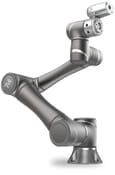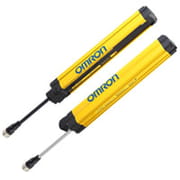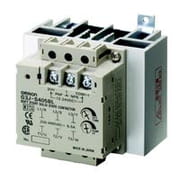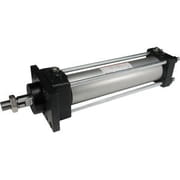Safety light curtains have emerged as a revolutionary technology that effectively protects employees and prevents accidents in high-risk environments. But how do they function, and why are they necessary? This guide will lead you on a tour of the inner workings of safety light curtains, illuminating their fundamental principles and highlighting their distinctive benefits. We will go through the different types of available safety light curtains, their installation procedure, and how they can be integrated into your existing safety systems.
What Is a Light Curtain?
A safety light curtain is an advanced safety device designed to safeguard personnel from harm and shield machinery from potential damage. This device utilizes one or more light beams, emitted by a transmitter, and received by a receiver, to create an invisible safety screen. The interruption of these light beams initiates a halt signal for dangerous, potentially hazardous processes, such as machinery operations.
The most straightforward function of a light curtain occurs when light beams are obstructed, and the outputs turn off, signaling the cessation of the associated dangerous movement(s). A reset can be performed if there has been no incident and the area is secure.
How do safety light curtains work?
Recommence Interlock
Automatic and manual are the two most common interlocking modes that can be set. In an automated way, output signal-switching devices (OSSD) go high when the beams are unobstructed. The OSSDs go high in manual mode when the rays are free, followed by a manual reset signal activation.
Continuous Device Monitoring (EDM)
The level of safety performance for a safety function can be enhanced by implementing fault detection. ISO 13849 and ANSI B11.26, which are utilized to measure the safety performance of an SRP/CS, define the term diagnostics coverage (DC) to quantify this capacity. It is a measurement of the number of detected hazardous failures.
External Device Monitoring (EDM) or "check back" is a method that has a diagnostics coverage of 99.9% (can detect 99.9% of dangerous failures) and is extensively used in the industry.
This monitoring function allows a safety device to actively monitor the status of external devices, such as machine primary control elements (MPCEs), contactors, and relays. It is necessary because external devices typically lack diagnostics and are considered "dumb" devices.
Blanking
In some applications, allowing specific objects to protrude through the light curtain field may be desirable without triggering an obstruction signal. For instance, when a support table or rack is required to input a heavy workpiece into the machine, a blanking feature can be used to modify the detection capability of the light curtain without interrupting the workflow.
Permitting Material Flow – Muting
In numerous applications, a light curtain must permit the passage of objects while still sensing the presence of people. It is especially essential on conveying lines where goods move from one production area to another or in automated warehousing operations where employees are prohibited from the automatic stacking and shelving areas.
Sensors can identify the object (such as a vehicle body) and allow passage into a hazardous zone based on its size and shape while still detecting the presence of a person. It is automatic and is referred to as muted.
Laser Beam Coding
Because safety light curtains operate at similar optical frequencies on the infrared spectrum, interference can occur between systems if multiple safety light curtains are used nearby, which could result in a hazardous situation.
Some light safety curtains feature beam coding so that a receiver can distinguish the beams from a specific transmitter without being affected by a nearby device. When beam coding is activated, however, the response time and range of the safety light curtain may be impacted, and this should be considered as it may affect the minimal safety distance.
Permitting Material Flow – Pattern Recognition
Some safety light curtains are capable of performing intricate algorithms on individual beams. It can detect whether the rays are blocked, which beams are blocked, and in what order.
The light curtain can detect patterns, objects, and directions without compromising safety, allowing known patterns to enter and exit the light curtain's detection zone. Furthermore, no additional sensors or control are required.
This full function can dramatically improve accessibility and security, enabling materials to pass through.
What Are the Resolutions of The Safety Light Curtains?
Omron provides a selection of safety light curtains (also called safety light screens) with varying resolutions to meet various industrial safety requirements.
For instance, the F3SG-RA and F3SG-RE series of light curtains from Omron provides the following resolutions
● 14 mm (Finger protection).
● 25 mm (Hand protection)
● 45 mm (Arm/Leg protection)
● 85 mm (Body protection)

Each resolution variety has a minimum safety distance to hazard mounting location recommended for optimal protection. This distance should be determined based on the pace at which a person could approach the hazard and the machine's stopping time.
The 14mm resolution light curtain in Omron's F3SG-SR series may provide a higher level of protection due to its smaller detection capability. However, it may have a slightly slower response time than the 25 mm resolution variant.Nevertheless, choosing Omron safety light curtains is beneficial due to their reliability, high-quality materials, and innovative technology.
Where are light curtains used?
Light curtains are used in various industries and environments where safety is paramount, especially where human interaction with machinery or other potentially hazardous equipment is conceivable. Here are several examples:
Elevators: Light curtains are utilized in elevators to detect any obstruction in the doorway. It prevents the doors from closing on someone or something.
Industrial Automation: They are utilized on assembly lines, presses, robotic stations, and numerous other automated systems to safeguard employees from harm.
Warehouses: Light curtains assure safety at automatic gates, conveyor belts, and palletizers in warehouses.
Medical and Pharmaceutical: In specific high-speed automated pharmaceutical production or medical diagnostic equipment, light curtains can prevent injuries.
Amusement Parks: In some amusement park rides where riders' limbs could extend out of the ride, light curtains detect such incidents and halt the passage if necessary.
How do you choose safety light curtains?
Resolution or Detection Capability: A light curtain's resolution refers to the tiniest object size it can detect. Higher resolutions (smaller number i.e. 14mm) allow for the detection of smaller objects. The slightest potential hazard should determine the key.
Range of Operation: The maximum and minimum distances a light curtain can cover. It must correspond to where you intend to install the safety light curtain.
Response Time: The light curtain's response time is crucial for safety. It refers to the rate at which the light curtain can signal to halt the machine if the light barrier is breached. It must be quicker than the machine it is protecting from stopping time.
Environment: The operating environment should be considered. For example, a light curtain with more robust protection may be required in dusty or unclean environments. Some light curtains are designed for environments with frequent washdown procedures, such as food production facilities
Safety light curtains have many international standards which can be followed to ensure compliance with the local laws and Regulations. These include, but are not limited to, CSA Z432 and CSA Z434 in Canada, ANSI B11.19 and OSHA standards in the United States and ISO 13855, ISO 13857 and EN 61496 in Europe.
Installation and Maintenance Ease: The light curtain must be simple to install and maintain. Self-diagnostic capabilities can be advantageous for equipment maintenance.
Integration with Control Systems: The light curtain must be compatible with the machine's control systems. It implies that it must be consistent with the extant systems for seamless integration.
Redundancy and Self-Checking: High-quality safety light curtains will have redundancy and self-checking capabilities to ensure they always function correctly. Industrial environments can be harsh, so you need a safety light curtain that is designed to last and is durable.
Reputation and Support of the Manufacturer: Finally, purchasing products from reputable manufacturers that provide excellent customer service and warranties is always a good idea. It ensures that you can access support if you experience any issues with the product.
Types of Safety Light Curtains
There are two main types of light curtains:
Machine Guard: Light curtains protect us from the hazardous portion of the machine. They are further classified according to their "resolution" or whether they can protect an arm, a hand, or even a digit.
Perimeter Guard: Light curtains encompass machine area access. The resolution is comprehensive since it will prevent people from gaining access to hazardous machine parts during critical machine operations. Determining where the curtain must be mounted is crucial to prevent a person from entering the hazard zone before the motion stops. It necessitates the measurement of the machine's stop time.
Safe Mounting Distance Calculation Formula
Ds =K x(Ts + Tc + Tr + Tbm) + Dpf
K: is a speed constant. The value of the speed constant is dependent on movements of the operator (i.e. hand speeds, walking speeds, and stride lengths). This parameter is based on research data showing that it is reasonable to assume a 1600 mm/sec (63 in./s) hand speed of an operator while the body is stationary. The circumstances of the actual application must be considered. As a general guideline, the approach speed will vary from 1600 mm/s (63 in./s) to 2500 mm/sec (100 in./s). The appropriate speed constant must be determined by the risk assessment.
T: is the overall stopping time of the system. The total time, in seconds, starts from the initiation of the stop signal to the cessation of the hazard. This time can be broken down to its incremental parts (Ts, Tc, Tr and Tbm) for easier analysis. Ts is the worst stopping time of the machine/equipment. Tc is the worst stopping time of the control system. Tr is the response time of the safeguarding device, including its interface. Tbm is additional stopping time allowed by the brake monitor before it detects stop-time deterioration beyond the end users’ predetermined limits. Tbm is used with part revolution mechanical presses. Ts + Tc + Tr are usually measured by a stop-time measuring device if the values are unknown.
DPF: The Depth Penetration Factors is represented by the symbols C and Dpf. It is the maximum travel towards the hazard before detection by the safeguarding device. Depth penetration factors will change depending on the type of device and application. Appropriate standard must be checked to determine the best depth penetration factor. For a normal approach to a light curtain or area scanner, whose object sensitivity is less than 64 mm (2.5 in.), the ANSI and Canadian standards use:
Dpf = 3.4 x (Object Sensitivity – 6.875 mm), but not less than zero.
For a normal approach to a light curtain or area scanner, whose object sensitivity is less than 40 mm (1.57 in.), the ISO and EN standards use:
C = 8 x (Object Sensitivity – 14 mm), but not less than 0
Difference between Type 2 Light Curtains and Type 4 Light Curtains
|
Factor |
Type 2 Light Curtains |
Type 4 Light Curtains |
|
Safety Level |
Lesser level of safety |
Higher level of safety |
|
Fault Detection |
Limited fault detection |
Sophisticated fault detection |
|
Redundancy |
May require redundant components |
Includes self-checking and redundancy |
|
Application |
Less dangerous settings |
High-risk settings |
|
Safety Standards |
EN/IEC 61496-1 Type 2 |
EN/IEC 61496-1/-2 Type 4 |
|
Response Time |
Slower response time |
Faster response time |
Contact us today to discover how our team can help you select the right Safety Light Curtains for your needs, maximize efficiency, and push the boundaries of what's possible.







